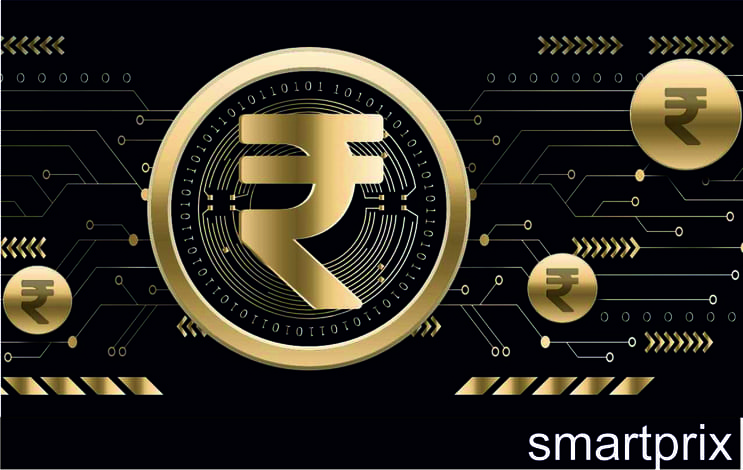RBI comes out with Digital Rupee (GS Paper 3, Economy)

Why in news?
- The Reserve Bank of India (RBI) recently launched the Central Bank Digital Currency (CBDC), digital rupee or e-rupee (e₹) for the common man.
What is CBDC or the digital rupee?
- CBDC is a legal tender issued by the RBI in digital form. It is the same as the fiat currency, and is exchangeable one-to-one with the fiat currency. Only its form is different, it is not paper (or polymer) like physical cash.
- It is a fungible legal tender, for which holders need not have a bank account. CBDC will appear as ‘liability’ (currency in circulation) on the RBI’s balance sheet.
- The e-rupee will be in the form of a digital token representing a claim on the central bank, and will effectively function as the digital equivalent of a banknote that can be transferred electronically from one holder to another.
- A token CBDC is a “bearer-instrument” like a banknote, meaning whoever ‘holds’ the tokens at a given point in time will be presumed to own them.
How is RBI introducing the CBDC?
- The pilot launched will initially cover four cities; Mumbai, New Delhi, Bengaluru and Bhubaneswar and will be later extended to Ahmedabad, Gangtok, Guwahati, Hyderabad, Indore, Kochi, Lucknow, Patna, and Shimla.
- The pilot will work in a closed user group (CUG) comprising participating customers and merchants, the RBI has said. Select customers from the selected cities will get CBDC wallets with notes printed digitally with the RBI Governor’s signature.
- Eight banks will participate in the pilot; the State Bank of India, ICICI Bank, Yes Bank and IDFC First Bank in the first phase in the first four cities, and subsequently, Bank of Baroda, Union Bank of India, HDFC Bank, and Kotak Mahindra Bank.
- The scope of the pilot may be expanded gradually to cover more banks, users, and locations.
How can an individual use the e-rupee?
- E-rupees will be issued in the same denominations as paper currency and coins, and will be distributed through the intermediaries, that is banks. Transactions will be through a digital wallet offered by the participating banks, and stored on mobile phones and devices.
- Transactions can be both person to person (P2P) and person to merchant (P2M). For P2M transactions (such as shopping), there will be QR codes at the merchant location.
- A user will be able to withdraw digital tokens from banks in the same way she can currently withdraw physical cash. She will be able to keep her digital tokens in the wallet, and spend them online or in person, or transfer them via an app.
What are the types of e-rupee?
- Based on usage and the functions performed by the digital rupee, and considering different levels of accessibility, the RBI has demarcated the digital rupee into retail and wholesale categories.
- Retail e-rupee is an electronic version of cash primarily meant for retail transactions, which can potentially be used by almost everyone, and can provide access to safe money for payment and settlements.
- Wholesale CBDC is designed for restricted access to select financial institutions.
- It has the potential to transform the settlement systems for financial transactions undertaken by banks in the government securities (G-Sec) segment and inter-bank market, and make the capital market more efficient and secure in terms of operational costs, use of collateral, and liquidity management.
How is CBDC different from cryptocurrency?
- Being backed by the RBI, e-rupee is not comparable to private virtual currencies like Bitcoin that have mushroomed over the last decade.
- Private virtual currencies sit at substantial odds with the historical concept of money. They are not commodities or claims on commodities as they have no intrinsic value; claims that they are akin to gold seem opportunistic.
- Cryptos are not backed by the central bank; in fact, the RBI wants the government to ban cryptocurrencies in India.
What are the benefits of e-rupee?
- CBDC has the potential to provide significant benefits such as reduced dependency on cash, higher seigniorage due to lower transaction costs, and reduced settlement risk.
- To the extent large cash usage can be replaced by CBDCs, the cost of printing, transporting, storing and distributing currency can be reduced, the RBI says.
- Digital rupee has some clear advantages over other digital payments systems: payments are final, and thus reduce settlement risk in the financial system.
- When CBDC is transacted instead of bank balances, the need for interbank settlement disappears. CBDC can also enable a more real-time and cost-effective globalization of payment systems.
Is it vulnerable to cyber-attacks?
- The RBI concept paper says CBDC ecosystems may be at similar risk for cyber-attacks as existing payment systems.
- Cybersecurity considerations will need to be taken care of, both for the item and the environment.


